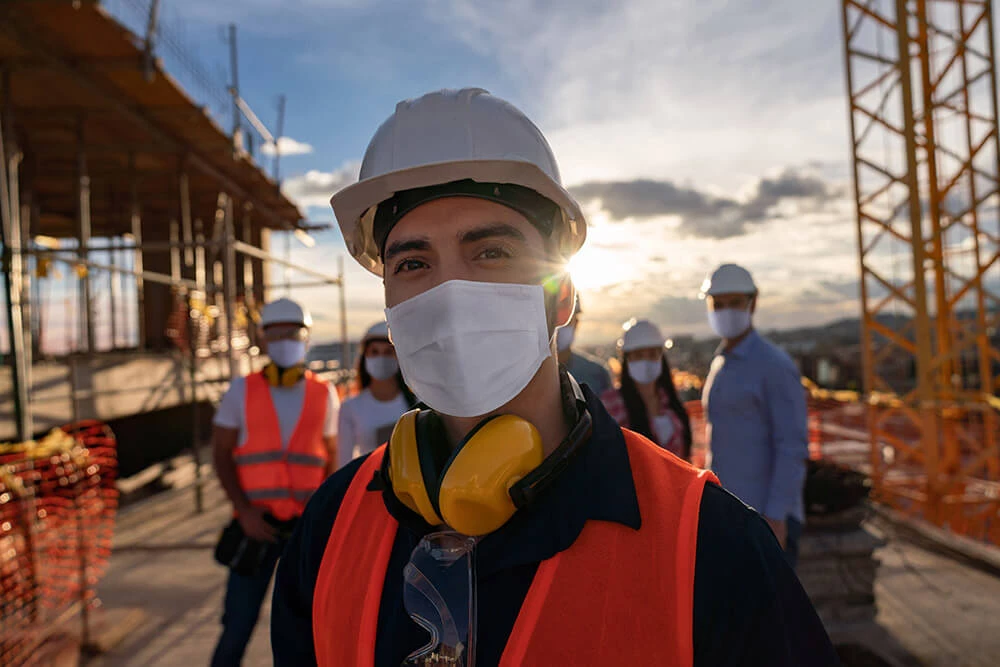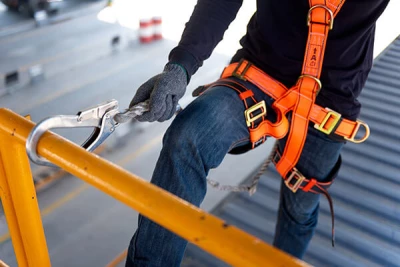Wildfire Smoke Awareness
Published July 4th, 2022
Over the past few years, the PNW has been severely affected by wildfires. There are many hazardous chemicals in wildfire smoke, the main harmful pollutant for people who are not very close to the fire is "particulate matter" - the tiny particles suspended in the air. The particles of concern are identified as PM2.5.
Breathing in PM2.5, or particulate matter, can lead to a range of health problems including:
- Persistent coughing
- Difficulty breathing
- Heart failure
- Phlegm
- Bronchitis
- Wheezing
- Aggravated Asthma
- Death
The greater the concentration of particulate matter is in the air, the greater the respiratory hazard is for you. The exposure to wildfire smoke is increasing every year and potentially presents serious health risks to all workers, especially those who work outside. When there is a respiratory warning issued for wildfire smoke, the management team (superintendents, foremen, project managers, and the safety department) will determine the air quality for exposure to PM2.5 before each shift and periodically thereafter using AirNow, Washington Air Quality Map, or Oregon Air Quality Today.
We will communicate the exposure controls when the PM2.5 levels exceed an AQI of 69 or higher via text, email, or phone. The controls include:
- Reducing, rescheduling, or relocating your work as best as possible
- Reducing the work intensity or increasing the amount of rest and break periods
- Encouraging the use of N95 or KN95 respirators
We recognize that everyone will have different and varying levels of sensitivity to wildfire smoke due to underlying health conditions. We encourage each employee to inform a member of their management team when air quality is worsening, or adverse symptoms are noticed while being exposed to wildfire smoke.
REMEMBER THIS!
Surgical masks or items worn over the nose and mouth, such as scarves, t-shirts, and bandanas, will not provide appropriate protection against wildfire smoke. n95 or kn95 filtering facepiece respirators are highly encouraged for use in areas where the AQI is above 69.
Burn Hazards & Injury Prevention
Published July 11th, 2022
Burn injuries are common both at home and in the workplace. The American Burn Association states that there are over 40,000 hospitalizations each year due to burns. Let's go over the 3 main types of burn injuries - thermal, chemical, and electrical.
Thermal Burns are what most people think of when burns are mentioned. These burns occur due to contact with a hot surface, fire, hot liquids, or an explosion. Sunburns could be considered a separate type of burn, but we will consider it a thermal burn as well.
Chemical Burns result from skin or eye contact with a strong acid, corrosive, caustic, or alkaloid. Many of the chemicals used in different processes at many job sites can result in a chemical burn injury. Some common household products can also produce severe chemical burns if not handled correctly.
Electrical Burns occur where are electrical current has passed through the body. When the current travels through the body, the tissue gives it resistance which results in burns both internally and externally. Usually, where the burns are on the outside of the body will indicate where the electrical current entered and exited the body.
How can I prevent burn injuries?
For thermal burns, the best way to reduce your chances of suffering from a thermal burn is to eliminate the source of heat, if possible. If there are other pipes or objects that heat up to dangerous temperatures, it is important to place guards or barriers on them to protect individuals from being burned. The last line of defense would be to use proper PPE that will protect you from being burned by a hot object or material, like using our Kevlar sleeves for steam work.
For chemical burns, eliminate the use of dangerous chemicals whenever possible. Substitute a chemical that burns the skin quickly, with one that does not burn as easily. Block areas or processes that have the chance to expose individuals to hazardous chemicals. Use the appropriate level of PPE, such as aprons, face shields, rubber gloves, and emergency showers and eyewash stations available for immediate use, if exposed to a chemical.
For electrical burns, safe work practices need to be followed to work safely around electricity. Locate and stay away from both underground and overhead powerlines. Inspect all tools of defects in insulation as well as missing ground prongs. Properly repair or discard any compromised cords. Do not operate electrical tools in moist or wet environments. Always properly lock and tag out equipment before performing your work on them. Try to turn the equipment on to ensure no power is still being given to it. The last line of defense is to wear PPE that protects you from electrical current.
Remember This!
Know the sources of burns both at work and at home. eliminate as many sources as possible before turning to engineering control or PPE to protect yourself from these hazards. always take the necessary time to mitigate burn hazards on the job.
Burn Severity & Treatment
Published July 18th, 2022
Last week we learned that there are over 40,000 hospitalizations each year due to burns. We also learned about the three main types of burns - thermal, chemical and electrical. Each can happen with varying degrees of severity and they are classified into three different levels. These levels are first degree, second degree and third degree.
First-degree burns: these burns are considered the least serious out of the 3 levels of severity. This burn affects the outside layer of the skin, also known as the epidermis. The burn site is red, painful, dry, and with no blisters. A mild sunburn would be an example of a first-degree burn. They are usually no long-term effects to the skin or body resulting from this level of burn.
Second-degree burns: these burns involve the epidermis and part of the dermis layer of skin. The burn site appears red, blistered, and may be swollen and painful.
Third-degree burns: these are the most serious type of burns a person can have. These burns destroy the epidermis and dermis, and may go into the subcutaneous tissue. The burn site may appear white or charred.
Treatment of Burns
- First-degree burns can be treated with over-the-counter ointments or medicines. First-degree burns usually heal on their own without treatment from a doctor. However, if your first-degree burn is very large, more severe, or if the victim is an infant or elderly person, seek medical assistance immediately.
- Second-degree burns can be treated using cool water. Right after the burn incident, run the affected area under cool water for 15 mins; using a compress if running water is not available. Do not apply ice! Applying ice can lower the affected areas body temperature which can cause further pain or damage. Protect the burn loosely using a sterile non-stick bandage and try not to break blisters or apply ointments as these can cause infections when applied to second-degree burns. Seek additional treatment at an emergency room if the burn area affects the hands, face, feet, groin, or buttocks.
- Third-degree burns can only be treated via medical professionals. When this incident occurs, call 911 immediately! Cover the area loosely with sterile, non-stick bandages. For larger areas, use a sheet or other material that won't leave lint in the wound. Seperate toes and fingers with dry, sterile dressings, under they are fused together. Do not soak the burn in water, or apply ointments as these can lead to infection. Prevent shock, lay the person flat, elevate their feet about 12 feet if possible or above the heart while they get transported to a hospital. Do not remove clothing - this could pull the burned skin from the body. Have a person with a facial burn sit up and continue to monitor for breathing and the onset of shock until emergency help arrives.
Remember This!
It's important to understand the different levels of burn severity and the necessary treatments. sometimes, third-degree burns are less painful that first or second-degree burns due to nerve ending loss. a person needs to be able to recognize when they have suffered a serious burn. if a severe burn does not get treated promptly, it could result in permanent scarring or disfigurement.
Substance Use Disorder: Opioids.
Published July 25th, 2022
The opioid epidemic is having a profound impact on our society, and the crisis is especially concerning for the construction industry, where our work can be repetitive and physically demanding. According to a study conducted by the Substance Abuse and Mental Health Administration, around 15% of all construction workers in the United States have a substance abuse disorder, this includes the use of alcohol, illicit drugs, or prescribed medications.
Why is that? To start with, we face a greater risk of injury because of the nature of our work. In fact, construction is the 4th most dangerous industry in nonfatal injuries. The top reasons behind nonfatal injuries were due to; slips, trips & falls, contact with an object or equipment and overexertion. When an injury like this occurs, opioids are often prescribed to help treat the pain.
How do opioids work – they bind to and activate opioid receptors on cells located in many areas of the brain, spinal cord, and other organs in the body, especially those involved in feelings of pain and pleasure. When opioids attach to these receptors, they block pain signals sent from the brain to the body and release large amounts of dopamine throughout the body. This release can strongly reinforce the act of taking the drug, making the user want to repeat the experience.
Because these drugs can create a feeling of euphoria, an opioid addiction happens easier than you may think. In fact, a three-day prescription can increase the chance for misuse by as much as 25%. This is an alarming statistic, especially when you consider that opioids are prescribed at a higher frequency to construction workers as compared to any other industry, as reported by the CDC.
Even though there are many stereotypes about what an addict looks and acts like, they rarely fit these descriptions. Many who are struggling with an addiction are working adults who have families to care for and bills to pay. Some have ended up addicted because they were over-prescribed medications.
Addiction is major issue for anyone, but there are additional risks for us. Our jobs always require our full attention, it doesn’t matter if you are driving a delivery truck, operating a scissor lift, or climbing a ladder, if anything impairs that concentration, it now becomes a risk. Being under the influence of any substances while you are at work increases the risk of making mistakes, which can be deadly to both yourself and your coworkers.





